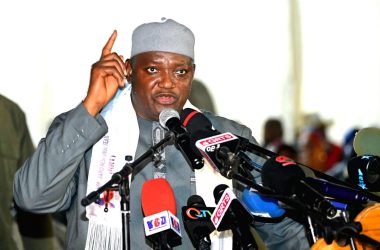
(JollofNews) – Section 226(1) states that an Act of the National Assembly may alter this Constitution subject to the directives of the said section 226.
In lay language, in order to alter certain provisions of the Constitution by the National Assembly, it must follow the directives of section 226. Section 226 has nine subsections to be exact but not all of them are directly at play when the National Assembly is in the business of altering certain provisions of the Constitution.
Section 226 (2) [here ignore reading “subject to subsection 226(4)” for a moment], so section 226(2) states that, a bill for an Act of the National Assembly under this section [meaning section 226] shall not be passed by the National Assembly or presented to the President for assent unless… . Now before getting into the requirements that follow “unless,” or what comes after “unless,” it is important to keep in mind that those requirements, which in combination make up subsection 226(2) are subject to subsection 4 of section 226.
In other words, the requirements of subsection 226(2)(a) and 226(2)(b) are subject to subsection 226(4) if any of the enumerated provisions under 226(7) is involved, and why, because if any of the enumerated provisions under 226(7) is in play then 226(4)(c) and 226(4)(d) are triggered, i.e., they are in addition to 226(2)(a) and 226(2)(b). But before getting into 226(4) and beyond, what does subsection 226(2)(a) and 226(2)(b) say?
Subsection 226(2)(a), here let us not forget that important word “unless.” So subsection 226(2)(a) should be read thus: while being subject to subsection 226(4) a bill for an Act of the National Assembly shall not be passed by the National Assembly or presented to the President for assent unless [before such bill is presented to the President] … the first reading of the Bill in the National Assembly, the Bill is published in at least two issues of the Gazette, the latest publication [That is, the last of the two required publications in the Gazette] being not less than three months after the first.
[This means between the first publication in the Gazette and the second publication in the Gazette, there should be at least three months interval], and the Bill is introduced into the National Assembly not earlier than ten days after the latest publication, [that is publication number two]. In other words, after the second publication, the Bill cannot immediately be introduced in the National Assembly less than ten days from the date of the second publication. So beginning from day eleven after the second publication, the Bill can be introduced to the National Assembly for consideration.
Subsection 226(2)(b) is rather straightforward. Going back to subsection 226(2)(a), where the first reading is to take place, hence “before the first reading,” you have the requirements of the first and second publications in the Gazette with the interval of at least three months between the first and second publications and the presentation, ten day after the second publication then comes the first reading in the National Assembly.
In subsection 226(2)(b), you have the requirements for the second and third readings of the Bill of with no less than three quarters of all the members of the National Assembly. In other words, the second reading and the third reading cannot be effective if there are less than three quarters of all the members of the National Assembly. So three quarters of the members of the National Assembly is the floor; can’t go lower than that.
Now to subsection 226(4); This subsection states that: A Bill for an Act of the National Assembly altering any of the provisions referred to in subsection 226(7) shall not be passed by the National Assembly or presented to the President for assent unless: … here the writers bring back the requirements of subsection 226(2)(a) and 226(2)(b) in addition to 226(4)(c) and 226(4)(d).
Now if you at look at subsection 226(4)(c) and subsection 226(4)(d) you notice the concern the writers of the constitution have about altering certain provisions of the constitution. In both 226(4)(c) and 226(4)(d) the word “referendum” can be found in the language of these two subsections. This demonstrates the big hurdle that must be overcome in order to alter those provisions enumerated under 226(7). I mean the additional requirements of 226(4)(c) and 226(4)(d).
Of particular concern lately has been the age limit for the office of the president and vice president respectively. Everyone knows that the age limit requirement is a bad provision. The question is how do you change it? The present administration wants to ignore all the requirements of section 226. If this is allowed to happen, then which provision in the constitution is safe? The age limit is repugnant to democratic principles, but this is not a license to ignore the requirements of the supreme law of the land. Whether a legitimate or illegitimate procedure was used to put the age limit in the constitution is not the issue.
The issue is that, in order to a change a constitutional provision a legitimate procedure has to be used. It should be as simple as that. The Minister of Justice has owned up to the snafu and that is a good thing, but we also suspect that the powers that be must have given their blessings to have that bill taken to the National Assembly in the first place. I am not going to waste my time getting into why the National Assembly passed those bills without any critical evaluation whatsoever. What has been disturbing is that we have “lawyers” in this administration who are supposed to know better yet keep on trying to bypass the supreme law of the land. That is unacceptable. In fact, such conduct reveals the ambitions and intentions of this administration. How can we have rule of law in The Gambia when the law is not respected?
One cannot claim rule of law but does not follow the directives of the law. We would rather this administration follow the directives of the supreme law of the land and stop preaching about the rule of law. To follow the law is not a choice but a duty.
There are those who have made the argument that the age limit provision is not included under section 226(7) and hence the requirements of 226(4) are not required. That, in my view is a wrong interpretation of the provision. Under subsection 226(7)(g) we read: “section 63(1) and the first sentence of section 71(2)(which [respectively] relate to the term of office of the President and the qualifications of Secretaries of State)”.
Now section 63(1) refers to the term of office of the president, but before one even begin considering the term of office of the president should we not see if the president and the vice president for that matter are qualified to the respective offices? And what is one of the disqualifications to those offices if not the repugnant age limit. We can debate whether subsections 226(4)(c) and 226(4)(d) are triggered when it comes to the issue of altering the age limit but there is no doubt that subsections 226(4)(a) and 226(4)(b), which really are 226(2)(a) and 226(2)(b) are triggered.
The age limit cannot be altered absent 226(4)(a) and 226 (4)(b) and those provisions under section 226(7) cannot be altered absent 226(4)(a),(b),(c) and (d). My interpretation is that to change the age limit, a “referendum” as mentioned in 226(4)(c) and 226(4)(d) is not required but there is no escaping 226(4)(a) and 226(4)(b). If 226(4)(a) and 226(4)(b), are triggered as I believe they are, then the requirements of the two publications in the Gazette with an interval of three months between the two publications and no less than ten days before presentation and first reading must be met.
If one is familiar with the relationship between necessary condition and sufficient condition then section 226 requirements make all the sense in world. Here it goes: under section 226, subsection 226(2)(a) and 226(2)(b) which are the same as 226(4)(a) and 226(4)(b) are necessary before the National Assembly can alter a constitutional provision. However, when any of the enumerated provisions under 226(7) comes into play, subsection 226(2)(a) and 226(2)(b) which are interchangeable with 226(4)(a) and 226(4)(b), though necessary, are not sufficient, because subsections 226(4)(c) and 226(4)(d) are triggered. Please feel free to disagree and let me know your reasoning.
By Gambian Insider






Where were all this legal luminaries when Yahya Jammeh declared Gambia an Islamic state contrary to Chapter 1 section 1 Subsection 1???
Buba, there was a consensus there – even Jammeh agreed that he was an OUTLAW!